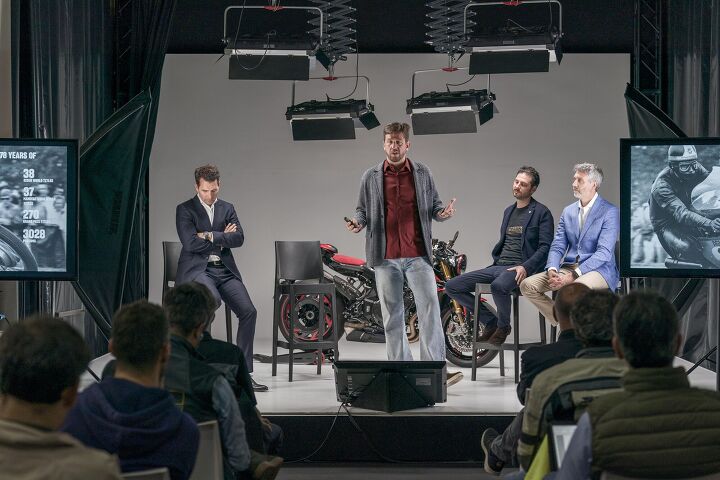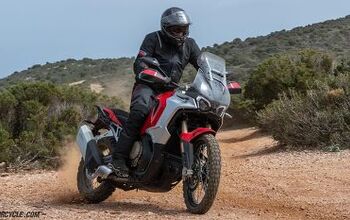What Does The Future Have In Store For MV Agusta?

With KTM AG behind it, MV Agusta has its best chance at financial stability. But we’ve heard this story before.
“This company was dead when I took over. It made no economic sense at all.”
Timur Sardarov doesn’t pull any punches. It’s not every day you hear a company’s CEO make such a bold statement, but such bold moves are a part of Sardarov’s playbook. Sardarov took over as MV Agusta CEO in 2019 after ComSar Invest, a venture capital firm run by the Sardarov family, bought out Giovanni Castiglioni and the Castiglioni family to claim a 100% stake in MV Agusta. With the keys to the palace, Sardarov quickly discovered that MV Agusta was great at leveraging its history to produce exotic luxury motorcycles people would lust over. What it couldn’t do was convert this lust into a profitable business. And, let’s not forget, MV Agusta is a business, after all. This is where Sardarov thought (and continues to think) he can make a difference.
Except we’ve heard this all before. The history of MV Agusta is fraught with failed attempts at solvency despite some big-name takeovers. Cagiva, which bought the rights to the MV Agusta name in 1991, didn’t produce a motorcycle – the stunning F4 750 – until 1999, and then MV went into receivership three years later, in 2002. Malaysian auto maker Proton, which was riding such a high that it was a primary sponsor of a MotoGP team at the time, bought a majority share of MV in 2004, only to sell it off after only one year.
Then of course, you have the famed takeover of MV by, of all companies, Harley-Davidson in 2008. It didn’t make much sense to many why Harley would do such a thing, but if ever there was a company that could take MV Agusta out of the depths of economic despair, it was Harley-Davidson. Fate had other plans, however, and in 2010, only two years into Harley’s ownership, and as the Great Recession devastated global markets, Harley cut its losses and sold the company back to Claudio Castiglioni for the grand sum of… 1 Euro.
The following decade saw MV move from hand to hand with minority stakeholders and even the Italian government helping to keep it afloat. In 2015, MV filed for bankruptcy. By 2017 Giovanni Castiglioni (Claudio’s son, who took over the family business after his father’s death in 2011) and Sardarov took back full ownership of MV Agusta, and by 2019 Sardarov bought out Giovanni to own MV Agusta outright.
This brings us to the present day, where in November of 2022 Sardarov made perhaps his boldest move yet in the profitability of MV Agusta, by allowing Pierer Mobility – KTM’s parent company – to acquire a 25.1% stake in MV Agusta. The extra 0.1% stake is important, as in European law 25.1% gives Pierer a seat on the board, and in turn, a much more influential voice in decision making.
Does This Mean Orange MV Agustas?
“Absolutely not”, says Florian Kecht, Pierer Mobility CSO. “We’re not going to copy and paste KTM onto MV Agusta. We’re going to build upon it.”
Squashing rumors and explaining the way forward was exactly the reason MV invited a select group of the world’s media to its HQ in Varese, Italy. Sardarov, together with representatives from Pierer Mobility like Kecht, wanted to ensure the collaboration wasn’t about turning MV Agusta orange, but rather, to allow MV to continue being the luxury brand of the motorcycling world. In fact, MV was going to lean into it harder than ever. Now with the financial backing of KTM AG.
The impact will largely be felt behind the scenes. Now MV has the power of KTM’s supply chain support and can leverage its purchasing power when negotiating with suppliers. In practical terms this means more parts can be acquired, and they can be had for cheaper. MV, in turn, can move in two different directions: it can either relay that cost savings into the final price of the motorcycle. Or it increases its own profit margins by keeping costs the same. Considering MV hasn’t turned a profit in a while and was “dead” when its CEO got his hands on it, we can likely guess which way MV will go.
But according to Kecht, this new partnership will entail wholesale changes across the board for MV, while also expanding the Pierer empire. MV Agusta is the luxury brand that forms the crown jewel on the company’s portfolio, and with a lack of conflicting models, the two sides won’t be cannibalizing sales from each other. MV will be able to slot right in with the four pillars of success that has brought KTM AG/Pierer Mobility to prominence today – Globalization, Innovation, Dealers, and Brands.
While it’s right to be skeptical of optimistic financial outlooks, if there was ever a company that could bring MV into the black, it’s Pierer. And while we’ve heard this song and dance before (Harley-Davidson, anyone?), when you factor Pierer’s total portfolio of products, not just MV Agusta, the company is positioned to have a foothold in nearly every corner of the world. There are production facilities in Europe, Asia, and South America, and an R&D department that is committed to racing as a means to improve the road products. The pieces are there. Now, it’s up to the MV and Pierer to deliver on the promise.
We can already see the influx of change affecting MV Agusta today. During my visit, construction was underway at the Varese HQ to build a second production facility to nearly double its capacity to 15,000 units a year. That’s still an extremely low volume compared to other manufacturers, but nonetheless is important for MV.
More importantly, the groundwork has begun to completely revamp MV’s dealer network, particularly in North America, which represents MV’s biggest opportunity for growth. According to Brian Gillen, MV Agusta R&D Director and a Buffalo, New York native himself, he sees the number one challenge for MV in the American market is trust. He finds that Americans are hesitant to buy an MV because there aren’t enough dealerships nearby. Worse, if an owner needs a part for their bike, they’re not sure if they can even get it.
The goal is for 180 dealerships across the country by the end of 2023, and the path to get there might be controversial. These dealerships need to be up to snuff, know the products, be able to carry parts, and be able to cater to a high-end clientele. If they’re selling a luxury product, they need to know how. However, instead of evaluating current dealerships, Pierer has wiped the slate clean of its MV Agusta dealers and has invited its now former dealers, as well as potential new ones, to apply for dealership status again. Kecht understood the method could seem harsh but reiterated that it wasn’t anything necessarily to do with the dealers. Instead, it was the most efficient way to move forward. And with 2023 half over at the time of this writing, the path to 180 seems like a steep mountain to climb.
Pierer’s Quest for Domination
When you combine the portfolio of KTM, Husqvarna, Gas Gas, CF Moto, and Felt bicycles, last year Pierer Mobility sold more vehicles than BMW, Ducati, and Triumph… combined. If Pierer’s vision is successful, great things will be in store for MV Agusta as well. But it’s worth stating again: We’ve heard this all before. Many have tried to revive MV Agusta, and all have failed. However, if ever there was a company with a legitimate shot at making this venture succeed, it’s Pierer Mobility and KTM AG.
Become a Motorcycle.com insider. Get the latest motorcycle news first by subscribing to our newsletter here.

Troy's been riding motorcycles and writing about them since 2006, getting his start at Rider Magazine. From there, he moved to Sport Rider Magazine before finally landing at Motorcycle.com in 2011. A lifelong gearhead who didn't fully immerse himself in motorcycles until his teenage years, Troy's interests have always been in technology, performance, and going fast. Naturally, racing was the perfect avenue to combine all three. Troy has been racing nearly as long as he's been riding and has competed at the AMA national level. He's also won multiple club races throughout the country, culminating in a Utah Sport Bike Association championship in 2011. He has been invited as a guest instructor for the Yamaha Champions Riding School, and when he's not out riding, he's either wrenching on bikes or watching MotoGP.
More by Troy Siahaan


































Comments
Join the conversation
It's probably not a great start to a new management regime if you disrupt the dealer network that current owners know and have relied upon. My closest MV dealer may (probably will) have to reapply, and I a wondering if it will be worth the effort. MVs these days are pretty frighteningly expensive, even when compared to high end Ducatis. And the trust still isn't there with the reliability. The basic quality control needs to improve so people can be confident they aren't pouring money into a hole to no benefit when they buy an MV. I am not sure a 25% stake by KTM will make that big a difference in the short to moderate term.
Beautiful Bikes ,Too Expensive And Relibility is suspect